I am super excited to share our family recipe for the delicious and lip-smacking arachuvitta vengaya sambar, precisely chinna vengaya sambar – South Indian style lentil stew with pearl onions or shallots and freshly ground coconut masala.
Here is the detailed arachuvitta vengaya sambar recipe with step-wise pictures!
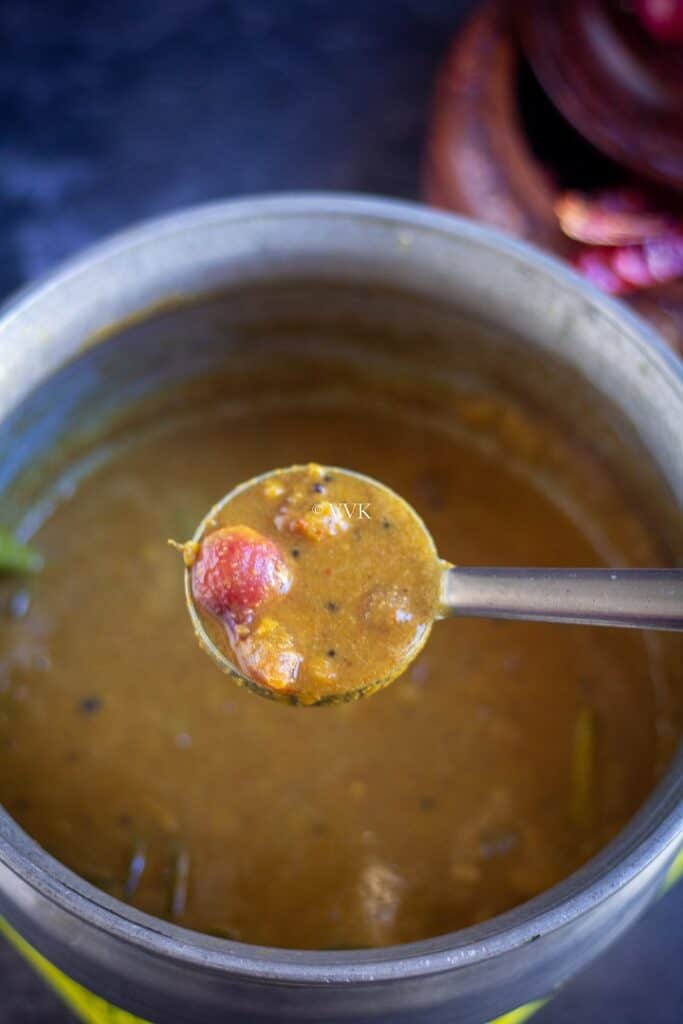
Ok, this is not my first arachuvitta sambar recipe on my blog. I have shared my mom’s arachuvitta sambar that has a strong coriander seeds flavor and her unique tiffin sambar. Also, I have other arachuvitta sambar recipes like Thiruvadirai sambar, pitlai, rasavangi, etc. I didn’t realize that my MIL’s version was missing, especially her onion sambar. Here I am amending that. :-)
Chinna vengayam translates to small onions, which is the pearl onions or shallots. So sambar that has pearl onions are chinna vengaya sambar. I have mentioned this on my blog before – we usually don’t load our sambar with veggies except for Thiruvadirai sambar. If we have to clean up our fridge, then we opt for avial or mixed vegetable sambar.
Usually, we add only one vegetable to the sambar and call the sambar by that name like vendakkai sambar, meaning sambar with okra—Mullungi sambar meaning sambar with radish. Likewise, today’s sambar is onion sambar, and yes, we don’t add any other vegetables in this sambar.
When I make drumstick or brinjal sambar, I add half of the medium-sized onion as we like that combination. But in most cases, I add just one vegetable.
I do agree, mixed vegetables brings a lot of flavors, and more veggies are always good. But folks, every vegetable has its unique flavor. You can enjoy the full flavor, especially radish, pumpkin, when you don’t mix them with other veggies. Do give it a try and I am sure you will definitely love it.
Also, some call this arachuvitta sambar as Kalyana sambar. Still, I am not sure if this version of mine is precisely the Kalyana sambar. Also, being a Kannadiga born and bought up in Tamil Nadu, ours is a mix of both Kannada and Tamil Nadu Brahmin style sambar.

So what’s so special about my MIL’s onion sambar or vengaya sambar-
- Along with freshly ground spices, she also adds homemade dry sambar powder that gives the sambar’s unique color.
- And while making the onion sambar, she also adds one shallot along with the masala and grinds it. Adding just one shallot while making the masala intensifies the flavor of the sambar.
- Most of the times she skips asafoetida but add mustard seeds while preparing the sambar masala. There isn’t a significant flavor change here, but that makes this sambar gluten-free and vegan naturally.
Steps involved in arachuvitta sambar-
There are three main steps involved in any arachuvitta sambar recipe-
- Cooking the toor dal or split pigeon peas. You can check out how I cook and freeze my lentils and use the frozen lentils also. But for this sambar, I used the freshly cooked lentils.
- Roast the spices and prepare the sambar masala. This freshly ground masala gives the sambar the name arachuvitta sambar.
- Prepare the sambar
These steps might sound lengthy, but the active cooking time is comparatively less. Now without any further ado, let’s get straight into the recipe.
Arachuvitta vengaya sambar recipe with detailed step-wise pictures-
Cook the toor dal-
- Rinse the toor dal and drain the water. Pressure cook the toor dal by adding 1 cup of water and ¼ tsp of turmeric powder for 3 to 4 whistles. Let it cool and mash it and set it aside.
- You can also cook in Instant Pot. As it’s ¼ cup of toor dal, you can use a PIP method and cook the toor dal for 20 to 25 minutes at high-pressure mode and release the pressure naturally.
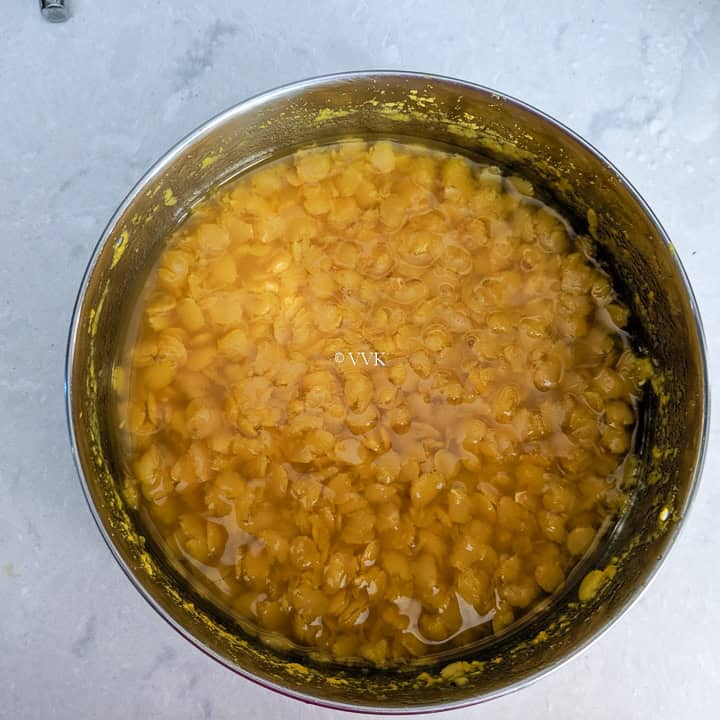
Roast and grind the masala-
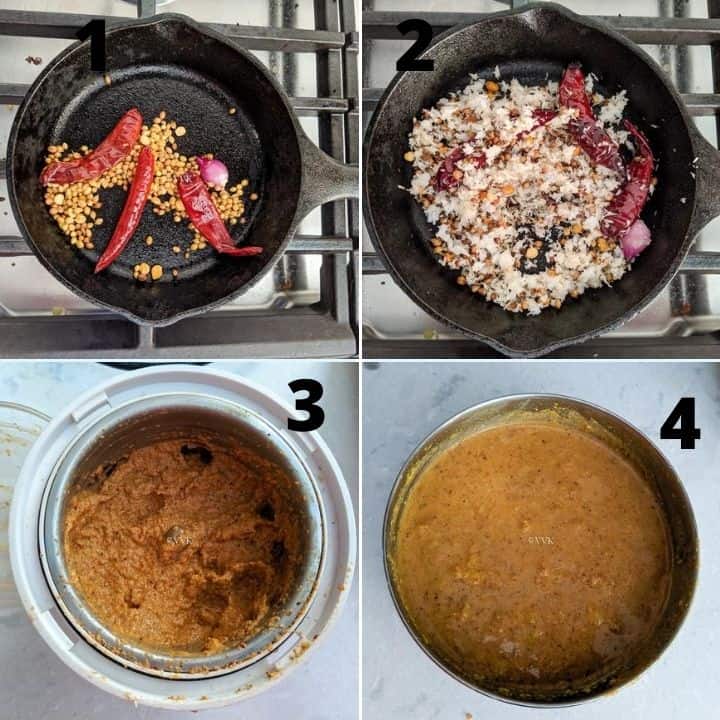
- Heat ½ tsp of oil in a pan and when the oil is hot, add the coriander seeds, chana dal, dried red chilies, mustard seeds if using and the shallot.
- Dry roast it until you get the aroma of the coriander seeds. Now add the coconut and roast for 30 seconds and turn off the heat. Let this mixture cool.
- Transfer these roasted spices along with the coconut into a mixer jar and grind into a smooth paste by adding ¾ to 1 cup of water.
- Now add this ground mixture to the cooked dal. Rinse the mixer jar with ¼ cup of water and add that water as well to the dal. Mix the dal and the ground paste together and set it aside.
Prepare the sambar-

- Take a saucepan or kadai with a heavy bottom, heat 1.5 tbsp oil. I used my uruli vessel for the sambar.
- When the oil is hot, add the mustard seeds and fenugreek seeds. You can add few curry leaves at this stage, but we did not add any.
- When the mustard seeds splutter, add the shallots and saute for 2 minutes. Then add ½ cup of water and cover and cook for 3 to 5 minutes until the shallots are tender.
- Now mix the tamarind paste with 1.25 cups of water and add it to the shallots. Add the salt as well and bring this to a boil.
- Add the sambar powder and mix well without any lumps. Let it cook for 3 minutes.
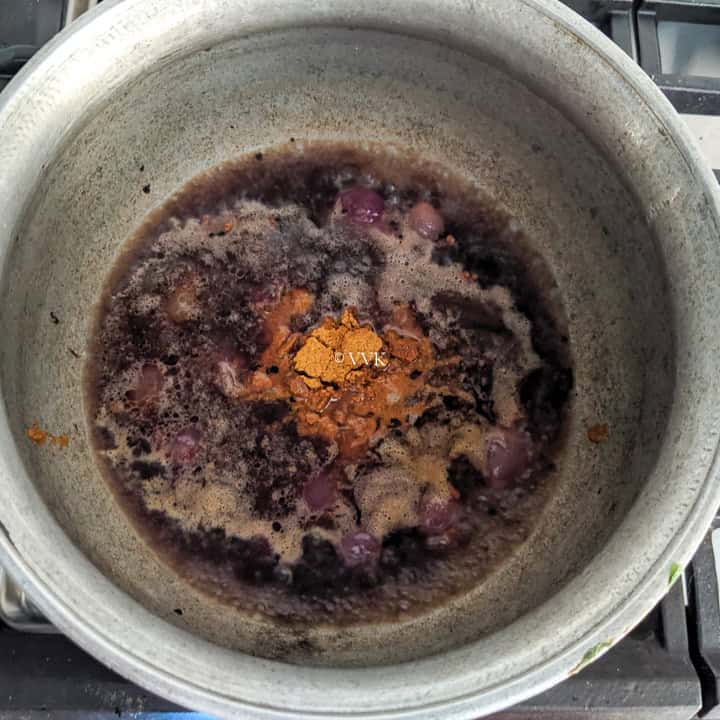
- Now add the dal and spice paste mix and jaggery to the sambar and mix thoroughly.
- Reduce the heat to medium-low and bring it to a gentle boil. The sambar will become frothy, and when it starts to boil, turn off the heat.
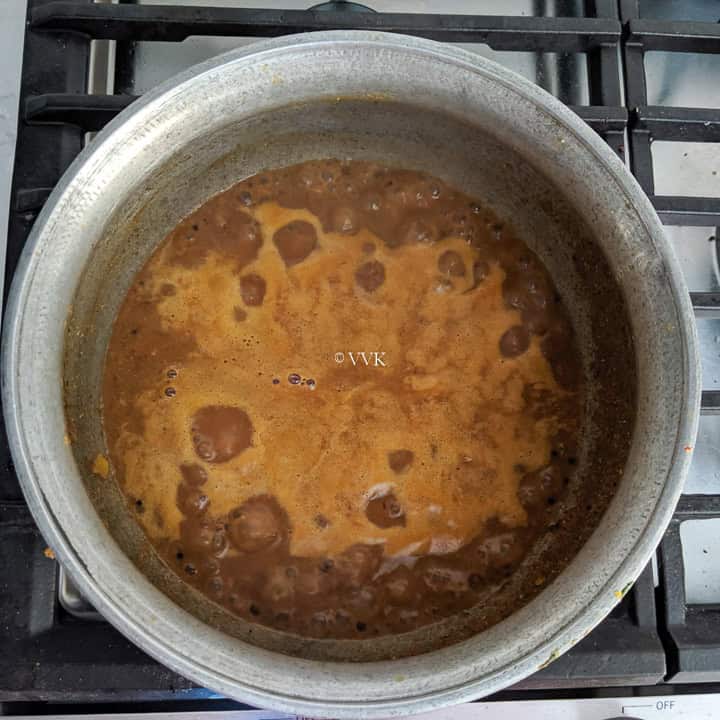
- Now add the curry leaves and cover the sambar partially. Let the flavor infuse.

Recipe Notes-
- As this is an exclusive onion sambar, I did not add any other veggies. But you can always add either okra or drumstick or brinjal. They go very well in this sambar.
- Instead of shallots, you can use regular big onions as well. In that case, while grinding add 1 tbsp of chopped onion. If you are using regular onions, chop them roughly into wedges or big chunks. Do not chop them finely.
- Check the consistency of the sambar towards the end and adjust the water accordingly. If the kuzhambu is thick, then add ½ more cup of water and simmer for 2 to 3 minutes. If sambar is thin in consistency, mix ½ tsp of rice flour with 2 tbsp of water and add it to the sambar. Bring it to a boil and turn off the heat.
- As always, adjust salt and spice according to your preference. The same goes for tamarind also. I have explained about tamarind in my vathal kuzhambu post. The tamarind you use plays a significant role. The age of the tamarind determines the tanginess and the color of the sambar. So adjust the tamarind according to the variety you have.
- You can add ⅛ tsp of asafoetida. We don’t add cilantro to sambar and also ginger-garlic paste. Jaggery is optional.
- I recommend adding coconut oil for this recipe. But you can add any other oil of your choice.
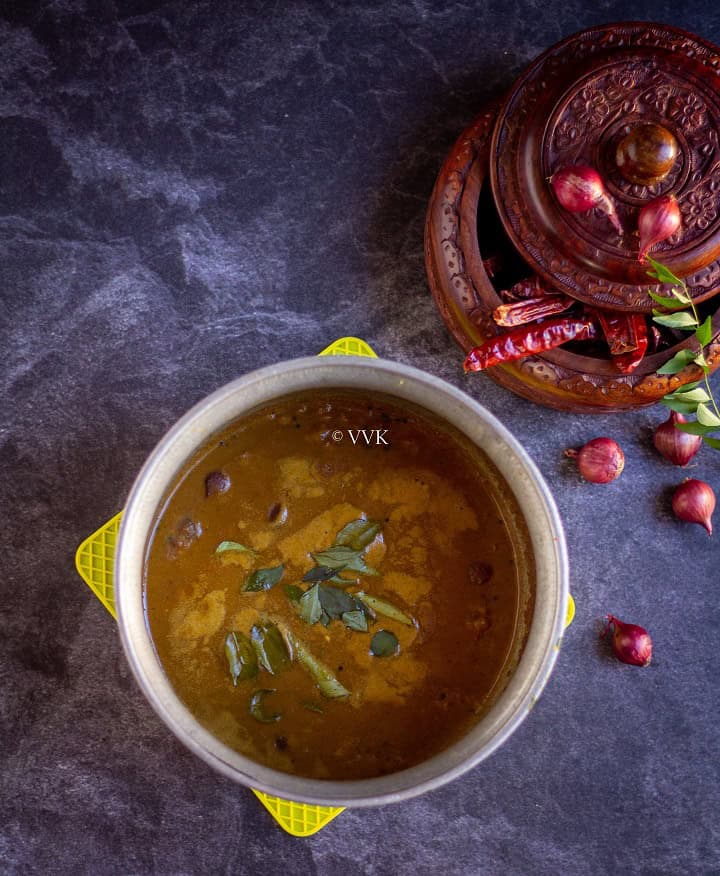
PS: Follow me on Instagram or join my Facebook Group for more gardening and recipe updates. If you try this vengaya sambar recipe, please don’t forget to comment and rate this recipe. If you have any questions, please leave a comment, and I will get to it asap. Make sure to follow me on my Pinterest for more healthy and delicious ideas!
📖 Recipe
Vengaya Sambar | Arachuvitta Vengaya Sambar
Equipment
- Instant Pot or Pressure Cooker
- Saucepan or kadai
Ingredients
Measurement Details: 1 cup=240ml; 1 tbsp=15ml; 1tsp=5ml;
For the dal-
- ¼ cup toor dal split pigeon peas
- 1 cup water
- ¼ tsp turmeric
To roast and grind-
- ½ tsp oil
- 1 tbsp coriander seeds
- 1 tsp chana dal split desi chickpeas
- 3 dried red chilies
- ⅛ tsp mustard seeds optional
- 1 shallot peeled
- ¼ cup coconut grated
- 1.25 cups of water divided
Other ingredients-
- 1.5 tbsp oil
- 1 tsp mustard seeds
- ½ tsp fenugreek seeds
- 30 shallots peeled
- 1 tbsp tamarind paste
- 1 tbsp sambar powder
- 1.25 cups water
- 2 tsp salt
- ½ tsp jaggery optional
- 5 to 10 curry leaves
Instructions
Cook the toor dal-
- Rinse the toor dal and drain the water. Pressure cook the toor dal by adding 1 cup of water and ¼ tsp of turmeric powder for 3 to 4 whistles. Let it cool and mash it and set it aside.
- You can also cook in Instant Pot. As it’s ¼ cup of toor dal, you can use a PIP method and cook the toor dal for 20 to 25 minutes at high-pressure mode and release the pressure naturally.
Roast and grind the masala-
- Heat ½ tsp of oil in a pan and when the oil is hot, add the coriander seeds, chana dal, dried red chilies, mustard seeds if using and the shallot.
- Dry roast it until you get the aroma of the coriander seeds. Now add the coconut and roast for 30 seconds and turn off the heat. Let this mixture cool.
- Transfer these roasted spices along with the coconut into a mixer jar and grind into a smooth paste by adding ¾ to 1 cup of water.
- Now add this ground mixture to the cooked dal. Rinse the mixer jar with ¼ cup of water and add that water as well to the dal. Mix the dal and the ground paste together and set it aside.
Prepare the sambar-
- Take a saucepan or kadai with a heavy bottom, heat 1.5 tbsp oil. I used my uruli vessel for the sambar.
- When the oil is hot, add the mustard seeds and fenugreek seeds. You can add few curry leaves at this stage, but we did not add any.
- When the mustard seeds splutter, add the shallots and saute for 2 minutes. Then add ½ cup of water and cover and cook for 3 to 5 minutes until the shallots are tender.
- Now mix the tamarind paste with 1.25 cups of water and add it to the shallots. Add the salt as well and bring this to a boil.
- Add the sambar powder and mix well without any lumps. Let it cook for 3 minutes.
- Now add the dal and spice paste mix and jaggery to the sambar and mix thoroughly.
- Reduce the heat to medium-low and bring it to a gentle boil. The sambar will become frothy, and when it starts to boil, turn off the heat. Now add the curry leaves and cover the sambar partially. Let the flavor infuse.
Notes
- As this is an exclusive onion sambar, I did not add any other veggies. But you can always add either okra or drumstick or brinjal. They go very well in this sambar.
- Instead of shallots, you can use regular big onions as well. In that case, while grinding add 1 tbsp of chopped onion. If you are using regular onions, chop them roughly into wedges or big chunks. Do not chop them finely.
- Check the consistency of the sambar towards the end and adjust the water accordingly. If the kuzhambu is thick, then add ½ more cup of water and simmer for 2 to 3 minutes. If sambar is thin in consistency, mix ½ tsp of rice flour with 2 tbsp of water and add it to the sambar. Bring it to a boil and turn off the heat.
- As always, adjust salt and spice according to your preference. The same goes for tamarind also.
- I have explained about tamarind in my vathal kuzhambu post. The tamarind you use plays a significant role. The age of the tamarind determines the tanginess and the color of the sambar. So adjust the tamarind according to the variety you have.
- You can add ⅛ tsp of asafoetida. We don’t add cilantro to sambar and also ginger-garlic paste. Jaggery is optional.
- I recommend adding coconut oil for this recipe. But you can add any other oil of your choice.
Nutrition
I am not a nutritionist. The nutritional information is provided as a courtesy and is an estimate only. It varies depending upon the product types or brands.





Hi Vidhya I tried your sambar yesterday as I had guests over and it came out so well. Thank you for this great recipe!
Thank you so much. Really appreciate it.
My husband does not like shallots in sambar so I have never made this. But I am so tempted to try this sambar for ages and your pics are making me tempted to do it soon. I will make this for myself and enjoy :D.
Oh no… I hope you get a chance to try it for yourself.
Vidhya these pics makes me drooling and hungry now. one of the best sambar and taste out of the world. Will check your other arachuvitta sambar recipes too.
Thanks a lot, Narmadha. :-)
I thought you are a Tamilian from Karnataka all these days going by your last name. :) And this flavorful sambhar is a fantastic choice for the platter.
I am the other way round. :-) Yeah from name everything like Tamil name only. :-) Thanks a lot Suma.
Yet another excellent sambar Srividhya, we all love the freshly ground arachuvitta sambar, tastes so out of the world!..love the pictures..
Thanks a lot, Valli.
Love the sambar masala freshly ground. I tend to add many vegetables to the sambar as I feel just the onions are inadequate. I know it is all in my mind. But I shall try to limit to one vegetable and try this.
Thanks, Harini. Do give it a try. You will definitely love it.